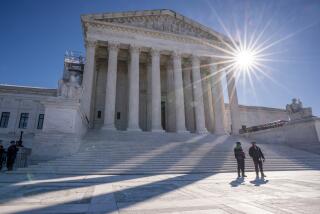Policing by Injunction Is a Feeble Hoax
- Share via
The recent California Supreme Court ruling upholding police use of civil injunctions to harass suspected gang members in neighborhoods overwhelmed by violence has been heralded by local police and welcomed by many people who are tired of youth crime.
The enthusiastic affirmation of anti-gang injunctions by the state’s highest court has also added momentum to the broad movement in our state and across our country that advocates criminalizing noncriminal conduct, if such conduct is engaged in by people out of favor--justifiably or not--with the social mainstream.
The court upheld the ability of police to obtain court orders prohibiting known or suspected gang members from standing on the street, engaging in conversations or possessing things like pagers and other items that might be used in criminal activity. These restrictions are necessary, the court held, to prevent gang crime.
Injunctions like the one in San Jose upheld by the Supreme Court on Jan. 30 have become popular throughout the state under a rationale articulated by Los Angeles County Dist. Atty. Gil Garcetti, among others. Garcetti has said that such injunctions do no violence to the liberty of anyone of consequence because “gang members have no constitutional right to terrorize neighborhoods.”
We agree. Gang members have no such right.
But as usual when a simple, cheap, tough and heavily promoted tactic is introduced by law enforcement, the initial hype--ginned up by the Supreme Court decision--makes it difficult to realize that the injunction tool has been vastly over-marketed. Worse, by portraying court orders to keep suspected gang members off the street as a solution to the problems of gang violence in our society, police and prosecutors ignore the far more pressing need to do something about why so many young people gravitate to gangs.
As laudable as the objective of making gang-ridden neighborhoods safe for all people is, the injunction tactic is doomed to fail. Here’s why:
Even police departments with the best of intentions make mistakes. Inevitably, people will be slapped with injunctions who have little or nothing to do with gang violence. Indeed, one of the people targeted in the San Jose injunction had never been linked to gang behavior in the neighborhood in question. She’d simply been seen driving nearby.
Injunctions--combined with the increasingly popular tactic of entering names and photographs of suspected gang members and gang wannabes in police computers--can have an effect opposite of what is intended by driving a young person on the periphery of gang involvement into active membership. Once branded a gang member by police, a young person may find it impossible ever to escape.
Gang injunctions may reduce violence temporarily in one neighborhood. They do so at the price of increasing violence someplace else, as gang members move on. This has the side effect of playing stricken neighborhoods against one another, as they compete to get injunctions to relocate gang crime instead of joining together to focus on the much more difficult issue of addressing root causes.
Injunctions ignore the reality that gang activity is widespread as a result of critical, broad problems that permeate our society. Without addressing deficits in education, job opportunity, recreational resources and--most important--the breakdown of the family, superficial remedies like injunctions will be as effective as treating a heart attack with rubbing alcohol.
There are already hundreds of laws that criminalize illegal conduct of gang members. Police need no injunction to find and arrest rapists, car thieves, drug dealers and robbers. What we should be doing is working with police to better equip them to use traditional--and constitutional--tactics to respond to the gang scourge. Unless or until that occurs, gang injunctions are destined to remain a cruel form of public safety hoax.
More to Read
Sign up for Essential California
The most important California stories and recommendations in your inbox every morning.
You may occasionally receive promotional content from the Los Angeles Times.













